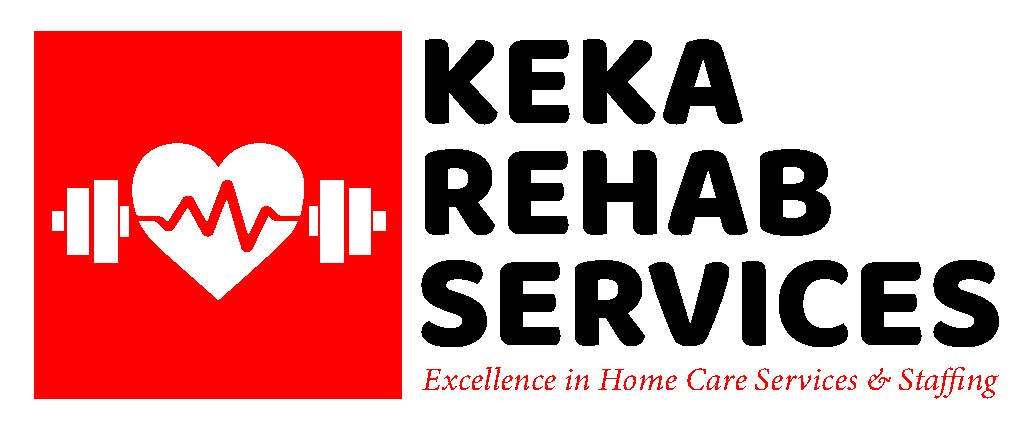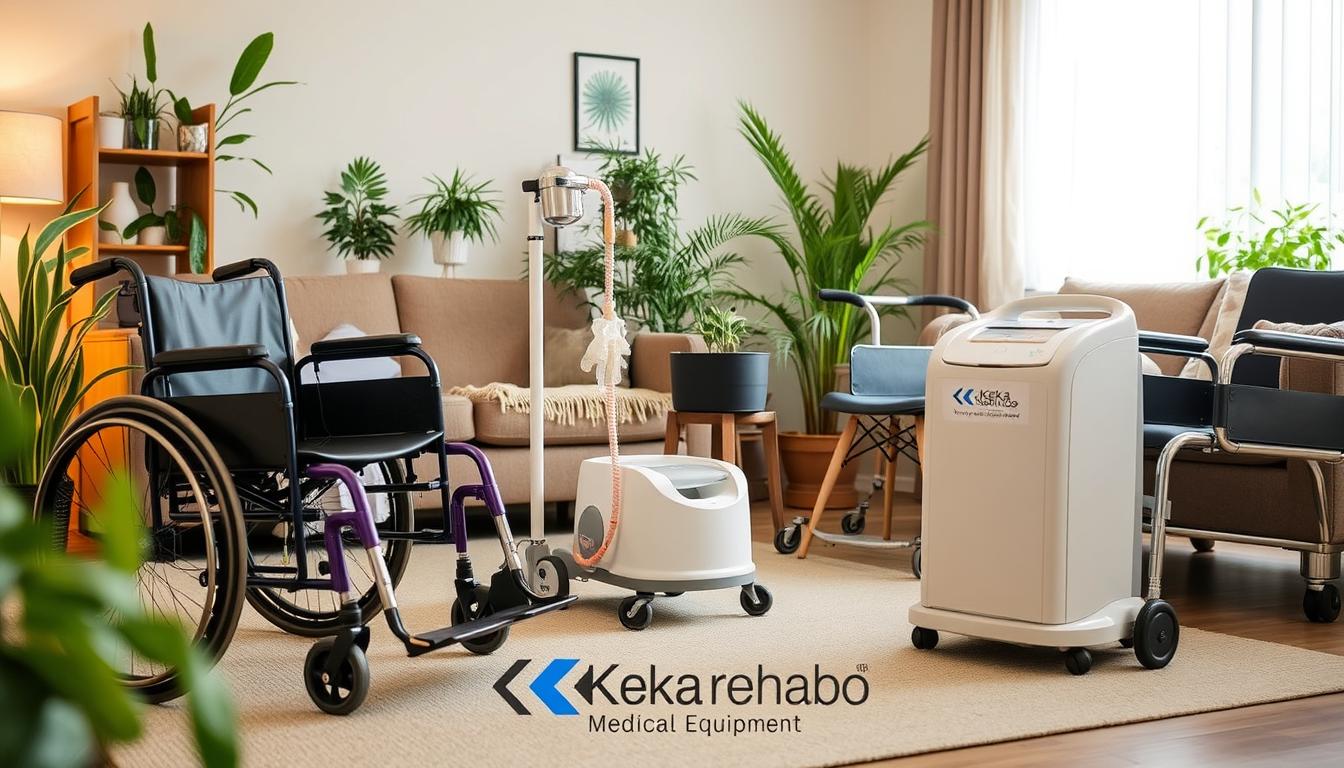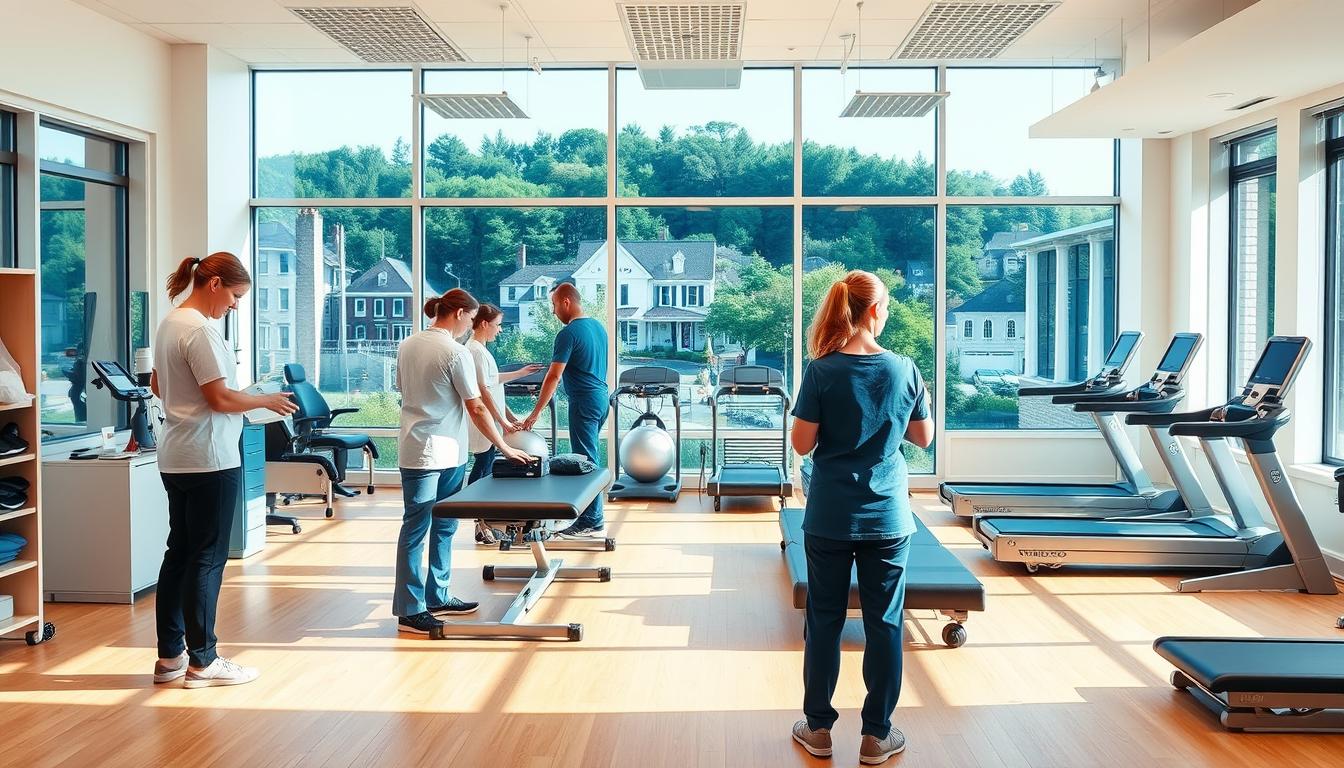Home medical equipment helps people with different health issues. It includes supplies for diabetes, ostomy care, wound management, and incontinence. These supplies help you stay healthy and independent at home. You get expert advice from clinical professionals like pharmacists, nurses, and respiratory therapists.
Home medical equipment does more than help individuals. Providers give back to the community by donating and working with over 180,000 healthcare workers to improve patient care. Their focus on quality care has made 98.4% of users recommend their services.
Key Takeaways
- Home medical equipment serves over 700,000 customers nationwide
- Providers offer a wide range of supplies for various chronic conditions
- Clinical professionals ensure expert guidance and support
- Community engagement and partnerships improve overall healthcare
- High customer satisfaction rates demonstrate the quality of service
- Home-based care promotes independence and comfort
Introduction to Home Medical Equipment
Home medical equipment (HME) is becoming more popular as people prefer to get treated at home instead of in hospitals. This change lets people take charge of their health and live better lives.
Definition and Importance
HME includes many devices for home health care, such as mobility aids, hospital beds, and oxygen therapy devices. These devices are made to last at least three years and are key for helping people with ongoing health issues or those recovering from surgery.
Benefits of Home Care
Getting care at home has many benefits. It lowers stress, cuts healthcare costs, and gives patients the same level of care as in hospitals. HME improves home care by being convenient and letting patients check on their health without often visiting hospitals.
Common Home Medical Equipment
Some key HME for homes include:
- Mobility aids like walkers and wheelchairs
- Hospital beds for safe recovery
- Respiratory aids such as CPAP machines and oxygen concentrators
- Monitoring devices like blood pressure monitors and glucose meters
These devices meet different needs, like regular blood sugar checks for diabetics or recovery after surgery with hospital beds. Experts in HME offer delivery, setup, and training to ensure the equipment is used and maintained properly.
Types of Home Medical Equipment
Home medical equipment comes in many forms to help with different health needs. Patient monitoring systems let you monitor vital signs and manage chronic conditions at home. You can also use devices like blood pressure monitors and glucose meters to stay on top of your health.

Bathroom safety equipment is vital to preventing accidents and keeping you independent. Items like shower chairs, grab bars and raised toilet seats make everyday tasks safer and more accessible. They are essential for seniors or people with mobility problems.
Wound care supplies are vital for healing wounds and preventing infections at home. They include dressings, bandages, and ointments for home use. Using these supplies correctly can help you recover faster and reduce hospital visits.
Other common types of home medical equipment include:
- Mobility aids (walkers, wheelchairs)
- Respiratory devices (oxygen concentrators, CPAP machines)
- Hospital beds and overlays
- Nutrition equipment
A wide range of home medical equipment is available, making it easier to get complex medical care at home. As healthcare costs rise and hospitals become full, home care is becoming more popular.
When picking home medical equipment, consider what you need and talk to healthcare experts. Many suppliers offer advice to help you find the right equipment. Using home medical equipment correctly can improve your life and improve your health.
Insurance Coverage and Affordability
Getting insurance coverage for home medical equipment can be challenging. Many people struggle to get the care they need. In a recent survey, one in three people said they faced delays or denials in getting care because of prior authorization requests.
In-network Coverage Benefits
Medicare and Medicaid often cover medical equipment that doctors say you need. Medicare Part B usually pays for a part of the equipment. But coverage can change. Some plans limit the types of equipment, how long you can use it, or how much it covers.
Working with Insurance Claims Experts
Handling insurance claims can be challenging. Some people have to appeal up to three times and wait six months for a decision. It’s essential to work with suppliers who know the process well.
Financial Considerations
Many people worry about out-of-pocket costs. One in four people had to buy their power wheelchair themselves. Nearly half were denied insurance for power wheelchair seat elevation, and many paid for ramps or rollators. To avoid surprises, always check your plan’s coverage details and get the proper documents from your healthcare provider.
Choosing the Right Home Medical Equipment Provider
Finding a trustworthy medical supply company is key to your health and comfort. Look for a provider that values product quality and customer service. Make sure they have a team of experienced staff, such as pharmacists, nurses, and respiratory therapists.

Choosing the right equipment is crucial. A good provider offers many options and helps you make smart choices. They should also explain insurance and costs to ensure you get great value.
Think about these points when picking a home medical equipment provider:
- Reputation and customer reviews
- Range of products available
- Insurance compatibility
- Delivery and setup services
- Ongoing support and maintenance
Quality equipment is vital for managing long-term health issues. Get expert advice to pick the best supplies for you. Consider what you prefer to ensure the equipment is easy to use and comfortable.
These factors can help you find a reliable medical supply company. This company will meet your needs and improve your life at home.
Home Medical Equipment: Enhancing Quality of Life
Home medical equipment is key to improving patients’ daily lives. It helps with mobility, independence, and overall well-being.
Improving Mobility and Independence
Lift chairs, wheelchairs, and walking aids change lives for those who can’t move quickly. They let you move around your home with ease and confidence. In the last five years, 35% more patients have started using these aids at home, which shows how vital these tools are for staying independent.
Managing Chronic Conditions Effectively
Home medical equipment is not just for moving around. It’s also key for handling chronic conditions. Tools like CPAP machines and portable oxygen tanks help with sleep and breathing problems. They’re great for people with COPD, asthma, heart failure, and other ongoing health issues.
Ensuring Safety and Comfort at Home
Your home should be a safe place. Equipment like patient lifts and gait trainers prevent falls and injuries. Nebulizers ease breathing for those with respiratory issues, and monitoring devices keep an eye on vital signs. 45% of households now own devices like blood pressure or glucose monitors, which shows that many people are taking their health into their own hands at home.
Using the right home medical equipment lets you live more actively, lessen symptoms, and boost your quality of life. It’s not just about physical health – 80% of patients feel more comfortable and independent with these tools. With the right equipment, you can stay safe, comfy, and in control of your health.
Maintenance and Support for Home Medical Equipment
Keeping your home medical equipment in good shape is crucial. Insurance often covers these devices, ensuring you get the necessary care. Regular care and quick fixes can make your equipment last longer and work better.
Many companies offer complete support services. For example, many healthcare companies have home medical equipment, delivery, and staff at most locations. This means fast and effective help when equipment is part of your care plan. They have a wide range of equipment, like oxygen devices, hospital beds, and mobility aids.
Technical support is a big part of keeping your equipment in good shape. Skilled technicians do regular check-ups, make needed changes, and fix things on-site. Our patients get to work with skilled medical technicians who are part of the hospice team and come to visit when needed. This kind of care ensures you can safely and effectively use your equipment, improving your life at home.
But maintenance isn’t just about technical help. It also means teaching patients how to use their devices right. Many providers teach patients how to use their equipment and keep an eye on it. Therapists check in on you every 1 to 3 months for things like ventilators or tracheostomy devices. By focusing on keeping the equipment in good shape and caring for the customer, these services aim to give you the best home healthcare experience.



